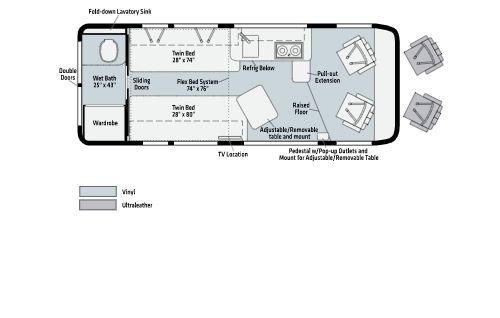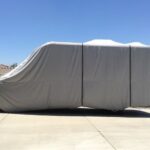This is a brief introduction to the Class B Motorhome type of RV, intended to provide essential information for choosing the best RV type. (Looking for Class B Manufacturers?)
Not sure if this is the right RV type for you? Please take a look at our RV Types Pros & Cons Checklist.
What Is a Class B Motorhome?

Definition of a Class B RV
Class B motor home is a recreational vehicle (RV) built on a commercial van or panel truck chassis and body. The driving compartment (cab) is an integral part of the RV interior (body). Class B motor homes look like passenger vans or commercial vans.
Unlike towable RV campers like 5th wheels and travel trailers, you drive a Class B motorhome. And no, you don’t generally need a special license to drive one!
Lengths range from 14 to 30 feet, with 16 to 24 feet being the most common. Width ranges from 7 ft (standard) to 8 ft (wide). The largest Class B’s are commonly called Super B’s or B+. The smallest Class B’s are usually conversion vans.
Most Class B RVs are tall enough to stand inside. The Class B motor home is created from a standard passenger or work minivan. Most models have raised roofs, but otherwise the living space is constrained by the dimensions of the van.
Height ranges from 7 to 9 feet. Most Class B’s can travel just about anywhere without restrictions, except for some urban parking garages and rough 4×4 unmaintained roads.
Class B motorhomes are sold with both gas and diesel engines. Many are FWD, but you can find RWD and AWD versions as well.
Class B’s are self-contained units, meaning they have everything you need: kitchen, bathroom, living and sleeping areas.
The smallest Class B’s can only fit 2 people, but most will accommodate 4-6 in a pinch. Some B+ RVs can fit 6+ in a pinch due to clever fold-down beds, but beware – it gets crowded!
Other terms include sleeper van or camper van. In RV vernacular, Class B is usually applied to factory-built units; conversion van is applied to units that started out as conventional vans and were subsequently converted to RVs.

Introduction to the Class B RV Model Type
Everyone loves a Class B motorhome. They’re so cute! And if you’re not afraid of small spaces, you’ll find there isn’t much a Class B can’t do. You get unparalleled flexibility and accessibility. Class B’s are just as well suited for hard-to-reach boondocking spots as stealthy urban camping.
All Class B motorhomes are built on commercial van or panel truck chassis. Big names include:
- Ram ProMaster
- Mercedes Sprinter
- Ford Transit
- Chevy/GMC Express
The smallest Class B’s might even be built on something as small as a Toyota Sienna minivan! These Lilliputian campers in many cases aren’t technically RVs at all. For regulation purposes, they are considered altered passenger vehicles.
When it comes to a Class B, the RV manufacturer typically doesn’t build the chassis or powertrain (thank God). In most cases, the manufacturer doesn’t even build the body, which has an automotive monocoque sheet metal design rather than laminated fiberglass or stick n’ tin RV construction. The vehicle is purchased incomplete from the chassis manufacturer, and the RV company merely outfits the interior and makes modifications. So think of the RV manufacturer more as the final assembler.
Who Might Want a Class B RV?
There is one obvious “downside” to a Class B RV. It’s the smallest motorhome you can buy. Even most travel trailers and 5th wheels are larger. You have far less privacy, cargo room and living space compared to any other motorhome.
There’s another compromise. You’re restricted to one vehicle. Unlike a Class A or Class C motorhome, a Class B motorhome
But if you can live with the Lilliputian dimensions, you’ll be mighty impressed by a Class B RV!
Oddly enough, the model type is suited for opposite ends of the camping spectrum. Serious boondockers love Class B RVs because they can be driven through regular roads, even high-clearance roads! Stealthy urban campers love that Class B’s are self-contained and can be unobtrusively parked just about anywhere.
Families may also prefer a Class B motorhome – or any motorhome style – to a towable RV for cross-country trips. There is no tow vehicle, and usually the living area seats are equipped with safety features such as airbags and seatbelts.
As a rule, Class B motorhomes seem to offer the best in construction quality of all the RV types. There are exceptions, of course, but you tend to see higher-quality finishes and appliances compared to other types, even to many Class A RVs!
(Psst. I dive deeper into this idea in this construction quality report from AskTheRVEngineer.)
Class B Motorhome Pros and Cons
PROS
- Least expensive motorized RV to own and operate.
- Quite fuel efficient! Average 10-15 mpg, with some models achieving up to 25 mpg!
- Easy to drive on highway and around town. This RV is constructed from a van, so it is just as easy to drive.
- Driving and living compartments are connected. No need to get out of the RV during stops. Living area accessible even while moving.
- It can be used as local transportation.
- Can tow a small trailer or support a carrying platform on hitch receiver.
- Can be used as a second family car when not traveling.
- Requires no special storage when not in use. Fits in standard driveway and lower models may fit in the garage.
- Can reach less accessible camping sites that are too tight for large RV’s.
CONS
- Limited space, practical only for short trips.
- Accommodates a small number of travelers.
- Very little visual or acoustic privacy.
- Expensive purchase price; the most expensive per square foot of any RV.
- Few full-sized appliances. Expect smaller refrigerators, microwaves, ranges, etc.
- Cannot tow a second “toad” vehicle. You have to pack up camp any time you want to drive away!

Key Features in a Class B Motorhome
Class B motorhomes have a reputation as one of the better-built types of RVs. You’ll find ingenious space-saving solutions, nifty cargo compartments, high-quality upholstery and European styling.
However, there’s more to the story. When does small become too small? What level of visual or acoustic privacy is necessary for you and your family?
Wet vs. Dry Bath?
Most Class B motorhomes have European-style wet baths, where the toilet is located in the same room as the shower. Only one person can use the facilities at a time. And unless you have a seat cover, the toilet will be wet after anyone showers. Wet baths are used because they are roughly half as large as a comparable dry bath.
Honestly, don’t knock it until you try it. Most campers transition quite easily to a wet bath setup. Just remember to keep your toilet paper in the covered holder!
Double-Duty Space!
Class B RVs are masterclasses in space efficiency. Nothing is too big. Everything fits just so. Every square inch has a purpose – and most have several.
Dedicated space is rare in a Class B motorhome. Your bed may fold up into a sofa. Your dinette doubles as an office space. Your toilet and shower share the same space. So you need to ask yourself if you’re willing to convert your bed every morning and evening, or if you’d rather have a larger RV with a fixed bed?
Or in same cases, such as shown below, the floor plan may feature fixed beds – but only as twin or bunk beds. If you want a double bed, you’ll need to convert.

2022 Thor Sequence 20A
As with most Class B layouts, the Sequence 20A features:
- Front driving cabin
- Convertible dinette seating area
- Kitchenette
- Wet bathroom
- Closet and cargo cubbies
- Convertible sleeping/sitting areas
Here’s an alternative layout from Winnebago.

2022 Winnebago Travato 59K
As you can see, most Class B RVs do not have slide-outs. What you see is what you get. Those that do have slide-outs keep them small, usually more for storage space than living space.
Downsized Features
Smaller RVs are forced to make the most of every square inch. In a Class B motorhome, space is a luxury.
So you typically won’t see residential-style features like kitchen islands, full-size refrigerators, dining room tables, double sinks, etc.
Instead, features and appliances shrink to fit the available space. Expect to see single-bowl sinks, 1- or 2-burner stovetops, 3- to 6-cubic foot fridge, 24- to 30-inch televisions, etc.

2022 Winnebago Travato 59K
Only you can decide if larger features and appliances are necessary for you. If so, you’ll want to look at a Class C motorhome.
Class B Motorhome Sub-Types
The Class B motorhome has two subtypes:
Class B+
Fair warning: There is no such thing as a Class B+. It’s a sales designation, not a regulated term. It’s a made-up word.
A B+, technically, is a Class C. It’s built on a cutaway chassis, not a passenger van. But unlike a traditional Class C, the width is usually kept limited to 7-ft, and there’s no front overhang.
Why no front overhang?
- Prefer a more streamlined appearance
- No need for the additional sleeping capacity
- More aerodynamic, van-shaped body
- Lower roof height for better accessibility
If you’re looking at a Class B+, then you should really be reading about Class C RVs.
Conversion Van
A traditional Class B RV is built on a van chassis, but it’s tall enough to stand up inside. You’ll also find traditional RV amenities and appliances inside. In industry parlance, a Class B motorhome is purpose-built vehicle designed by an RV manufacturer.
Meanwhile, a conversion van is like a squished, stealthy version of a Class B. Some aren’t tall enough to stand up inside! They tend to be smaller than traditional Class B’s. And they can be built on any available van platform, not merely a commercial chassis. Many are without bathrooms.
Conversion vans may be designed for uses besides camping, such as transporting large numbers of passengers, transporting the physically handicapped, or as a mobile mancave.
Class B Motorhome Major Manufacturers
There are about 20 major Class B motorhome RV manufacturers in North America.
Some of the biggest names include:
- Pleasure Way
- Leisure Travel Vans
- Roadtrek
- Regency
- Thor
For a full list of manufacturers, check out our comprehensive RV manufacturer’s list!
There are also dozens of custom conversion upfitters who will design you a bespoke Class B motorhome, complete with 4×4 packages, Murphy beds, wet baths, flat screen TVs, or whatever else your heart desires. They are not shown on our lists.
We’ve spotlighted a few brands below. These brands are either known for their popularity, quality, or innovation.
Roadtrek
Roadtrek is an RV manufacturer based in the state of Ontario and has been in operation since 1980/2019. The company is owned by RAPIDO GROUP.
Roadtrek builds modern Class B and Super B motorhomes for the Canadian and US market.
Their Class B model lineup includes the Play, Sumber, Chase, SRT, Zion, and Agile. MSRP ranges from approximately $100,000 to $250,000.
The company offers both factory and bespoke models. The vans can sleep 3-5. Most are built on the RAM PROMASTER 3500 EXTENDED VAN chassis, although the Agile is constructed on the Sprinter 2500 Series.
Pleasure-Way
![]()
Pleasure-Way is a long-established name in the Class B industry. As of 2022, the company produces seven model lineups, including a 4×4 RECON model and the diminutive Tofino conversion van. Prices range from $78k to $165k and up, up, and away!
But you get what you pay for. Beautiful interiors with advanced technology lithium batteries, built-in inverters, and touchscreen control panels.
Unlike other branches of the RV family tree, customer service is REALLY important in the Class B space. Pleasure-Way has a good reputation for putting the customer first, and that’s led to its sustainable growth and success.
Winnebago
![]()
Winnebago has been a big player in the Class B space for decades. In fact, they boast the number-one best-selling camper van in the country: the Travato.
Their lineup of Class B motorhomes includes the Solis, Travato, Revel, Era and Boldt. As with most of the other mainstream Class B manufacturers, prices quickly hit six figures and keep rising.
Lengths range from 17′ 10″ (Solis Pocket) to 24′ 3″ (Era). You have your choice of gas- or diesel engines. The lesser expensive motorhomes are built on the Ram ProMaster chassis. The more luxurious models are built on the Mercedes-Benz Sprinter, a perennial favorite.
As one of the five largest RV manufacturers, Winnebago outfits their RVs with many industry-standard features.
Class B Motorhome FAQs
Yes!
Class B motorhomes are good for “dry camping” or “Wallydocking,” the art of self-contained camping without hookups. Thanks to their propane, water and waste tanks, they can run off-grid. And in a pinch, you can always fire up the engine to get power!
They really shine for true primitive camping or boondocking, which usually involves tight spaces and high-clearance roads.
However, appliances on Class B motorhomes are power-hungry. You’ll need a hefty generator to run your RV for 48-72 hours off-grid with full use of appliances. And unlike larger RVs, Class B motorhomes typically don’t come with extra storage batteries or generators.
No. Class B motorhomes do not have sufficient GVWR to tow any vehicle, especially when loaded.
Related RV Checklists
The following RV checklists on our web site are applicable to Class B motor homes:







